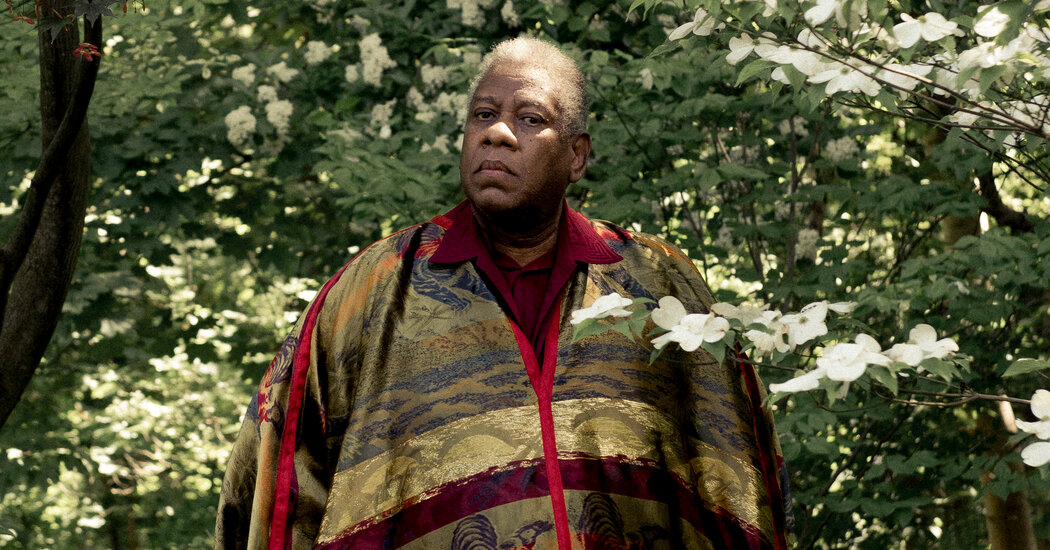
André Leon Talley was the last of his kind: a fashion editor who operated without the filter of a corporate public relations apparatus.
He made broad, extravagant declarations like, “We’re living in such a vulgar age!” He was the “pharaoh of fabulosity” who put himself on his own best-dressed lists and eviscerated celebrities whose red carpet ensembles weren’t up to his standards. In short, André Leon Talley spoke his mind, seemingly without fear.
“When he likes it, he says it very loud, and when he doesn’t like it, he says it very loud, too,” his friend, the designer Carolina Herrera, told Vanity Fair in 2013. “He’s either a volcano or an iceberg.”
Here, highlights from three decades of his life inside — and, later, far outside — the fashion system.
Mr. Talley knew from an early age that he wanted to work in fashion.
“When I was 14, my uncle asked what I wanted to be, and I said a fashion editor. He began screaming, ‘Scandal! Scandal! Scandal!’ My grandmother just looked at me.”
The New York Times, 1992
He never appeared to stop loving the job.
“Everything in life is about editing, whether it is editing your food, editing your clothes, editing the flowers, editing your room, editing your time.”
T: The New York Times Style Magazine, 2014
He knew that the decadent image he’d cultivated for himself wasn’t necessarily based in reality.
“You can be aristocratic, without having been born into an aristocratic family.”
“The Gospel According to André Leon Talley,” 2018
“In the world of fashion, you have to be hidden to survive. Think of Halston, Tom Ford, Karl Lagerfeld. They were very much cryptotic. They saw themselves as playing a role to their public. Who in the world really knows who they are?”
The New York Times, 2003
He believed fashion needed, above all, “optimism, hope and humor.”
“There is a sophistication lacking in American clothes. Everyone thinks it’s enough to put a pale blue cashmere sweater in six-ply with a terra-cotta skirt and call it fashion.”
The New York Times, 1999
And to be in touch with queerness. (He personally identified as sexually fluid.)
“The world has no choice. It must embrace and glorify the gay aesthetic.”
The Advocate, 1992
And he could communicate “silently” with his boss and friend Anna Wintour, even when it came to critiquing her personal fashion choices.
“I would never be so rude as to say, ‘You look bad.’” “I would say, ‘Oh, who made that?’ and my eyebrows would raise to the ceiling, and there would be a silence.”
Vanity Fair, 2013
He believed strongly in comfortable shoes (evident in his large collection of Uggs).
“Too many career women look like a herd of fashion beasts, aping one another in impractical shoes.”
Vogue, 2009
He was known for his signature caftans.
“I have more than 10 and less than 50. Listen, I’m not Marie Antoinette.”
The New York Times, 2016
But while his taste leaned toward opulence, he wasn’t above a bargain.
“I’ve shopped everywhere! I go to Kmart, I go to Wal-Mart, I go to Sam’s Club, I go to Target. I love those stores. One of the most therapeutic things you can do is go to Target with a basket and a trolley.”
The Cut, 2008
As a judge on “America’s Next Top Model,” where he appeared for four seasons, despite believing reality TV to be “a terrible thing,” Mr. Talley dispensed outrageous advice.
“There’s nothing worse than a woman with a camel toe at a cocktail party because then your eyes look at that and you don’t want to talk to her. You throw your hair back and you keep walking.”
The Wall Street Journal, 2010
He had strong opinions on air travel, which he called a “challenge to one’s mental state and ecstatic state of being.”
“I personally go to the airport looking like a homeless person, because I think people will leave me alone. But I dress myself with my luggage — all my luggage matches. But it’s so humiliating to be searched, and they take away your lotions — you just bought a $15 bottle of Kiehl’s, and it’s too big. You just never know what you’re going to get. So it’s better to just go as an anonymous person from Dallas.”
The Cut, 2010
As a red carpet critic, Mr. Talley could be deliciously vicious. He once said a ruffle on a dress worn by Christina Hendricks “thudded like industrial tarp along her body.” He compared Marion Cotillard to a “Ladurée coconut macaroon reject.”
“Whenever I see the red-carpet shows, I wonder what happened to these people. Who told them to get dressed that way?”
The Cut, 2010
He liked to spend time with friends in high places.
“I may have had moments of hauteur. H-A-U-T-E-U-R. But I was never a snob. You can ask [Princess] Gloria von Thurn und Taxis, or [Lady] Amanda Harlech!”
The Guardian, 2020
Like with Manolo Blahnik, at the shoe designer’s residence in Bath.
“Manolo will be in the kitchen cooking his wonderful cuisine, and I’ll be in the larder, lacquering my Louis Vuitton cases with yacht varnish, bringing them to a high shine.”
The Guardian, 2020
But he held the view that “luxury” was more of a state of being than an amassing of things.
“It’s not about going and buying the most extraordinary set of luggage or the most extraordinary ring or six-ply cashmere sweater — that’s luxury, too — but luxury can also be you having lunch with your best friend Karl Lagerfeld.”
Yale Daily News, 2010
He found refuge at home, in White Plains, N.Y., away from the city.
“I reconcile the toxicity of the fashion world with the beauty of home.”
The New York Times, 2010
But he acknowledged his life there was also a solitary one.
“I live alone. I’ll die alone, I climbed up alone, and I’ll go down alone.”
The New York Times, 2018






